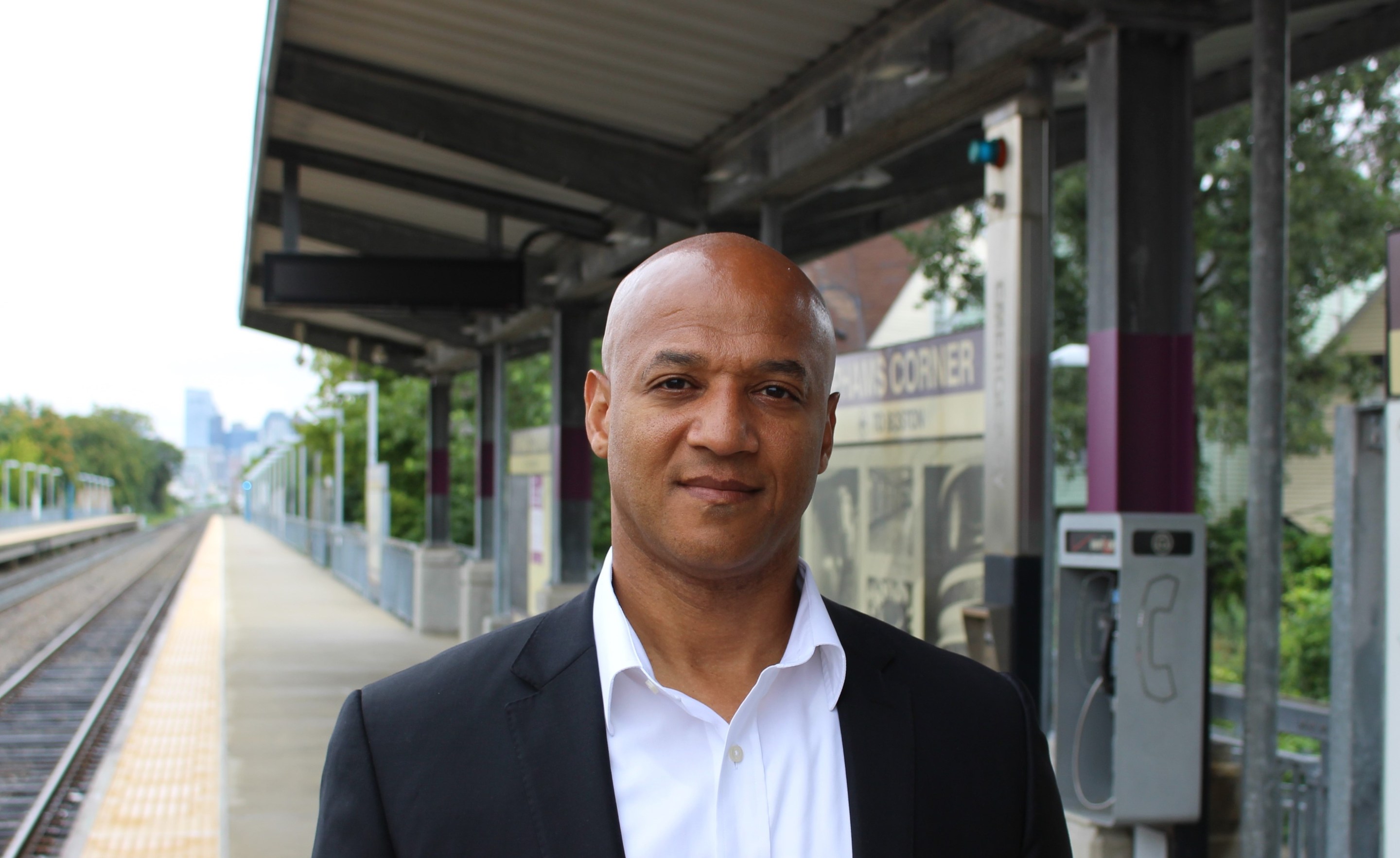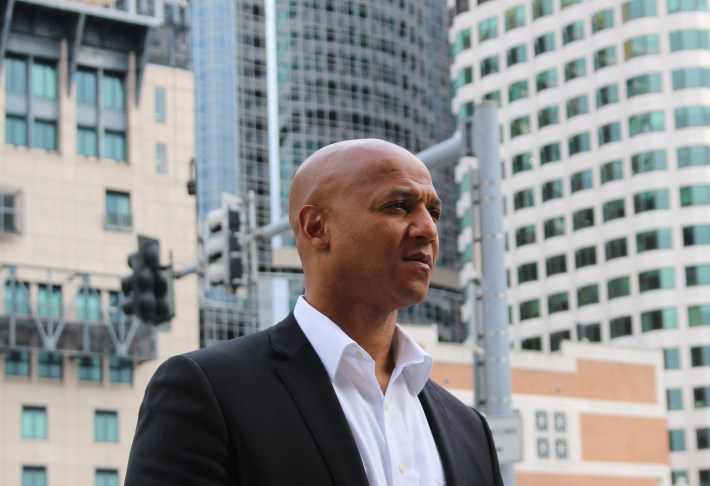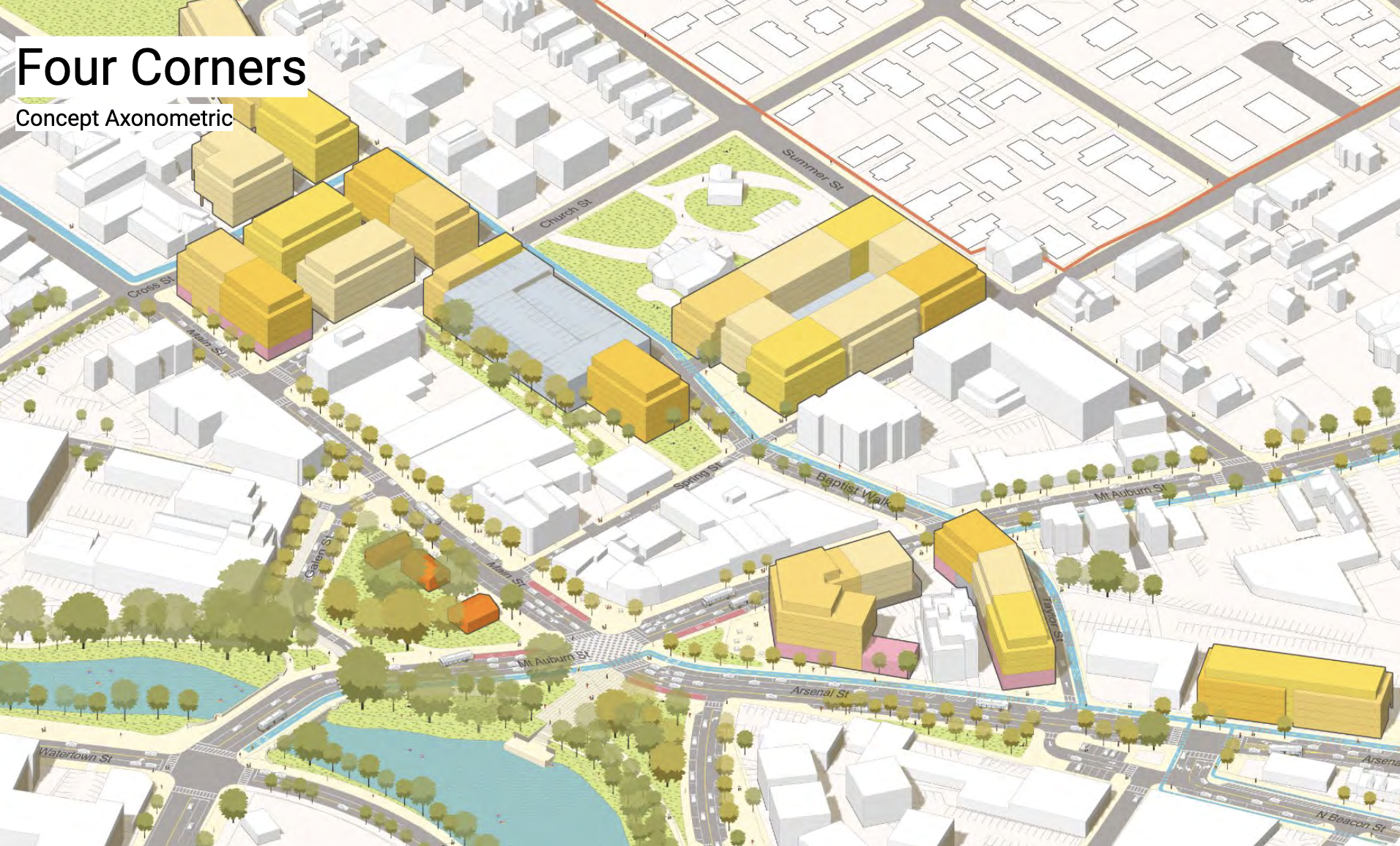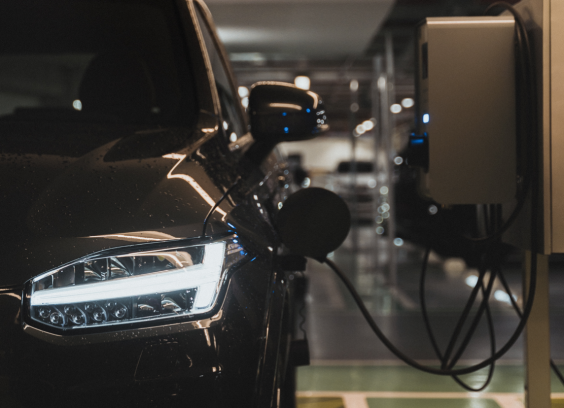Rides With the Candidates: John Barros On the Fairmount Line
5:51 PM EDT on August 18, 2021

John Barros, candidate running to be Boston’s next mayor, on the train platform at the Upham’s Corner station on August 10, 2021.
This summer, StreetsblogMASS has invited each of the major contenders in Boston’s mayoral race to join us for a walk, bike ride, or transit trip that’s personally meaningful to them and have a conversation about their ideas for what Boston’s next mayor should do to address the challenges of safe mobility, climate change, and affordable housing.
A preliminary election on Tuesday, Sept. 14 will eliminate all but two candidates from the race. Voters will then choose between the two finalists in the general election on Tuesday, Nov. 2. Boston residents can find out more about how and where to vote here.
John Barros, Mayor Walsh’s former Chief of Economic Development, was the first candidate to take us up on our invitation, and suggested we meet for a ride to South Station on the Fairmount Line from his home neighborhood of Uphams Corner on the morning of Tuesday, August 10.
The following is a transcript of our conversation, edited for length and clarity.
Can you introduce yourself for Streetsblog readers who may not know who you are?
My name is John Barros. I was born and raised in this neighborhood, and this neighborhood, as you can tell, outside of the bus line running up and down Dudley Street, the Fairmount Line was our primary opportunity to get to the job center downtown. I used to wake up early in the morning and take this train to South Station so I could get to work. I had an internship at 1 Financial Center, and this was my train.
But it was inconsistent. There were mornings when it just didn’t show up and they decided it wasn’t going to run. And when that happened there would be a number of us on this platform - and back then, the platform looked nothing like this, it was a mess - and we couldn’t get to work. We would have to figure out how to take a cab or share a ride with each other and try to get downtown.
We ended up fighting, as a neighborhood, to try and improve service… I’ve been working on this line for a very long time. We were successful in getting them to invest some money - including redoing this platform and others along the line. We were successful in getting them to reopen stations… fighting for transit equity and service is something that I’ve been doing pretty much all my life in this neighborhood.
You worked for the Walsh administration, running the economic development office. Can you tell me a little bit about how the Fairmount Line plays into your interest in economic development?
As Chief of Economic Development, I understood that transit is a part of our economy, and a really important part of how we grow our economy: how people get to jobs, how people get to other businesses, how people move around the city and connect to opportunities.
I worked very closely with then-Chief of Streets Chris Osgood to talk about how we improve the transit system, work with the state to invest in and expand transit. In fact one of the lines we worked on together was this line: during the Walsh administration, we worked with the MBTA to open the Blue Hill Avenue stop and make other investments along the line, including improving services.
The T is a state agency, and has a lot of competing regional interests. What can the city government do to influence the MBTA?
Transit, like other things in Boston, is run by the state. And so an effective administration for the City of Boston would have a strong relationship with the state, to be able to work on things like transit, work on taxes, investments in different areas of our economy in the city. I have a very good relationship with the Baker administration…
(at this point, an arriving outbound train interrupted our conversation)
So there’s no reason to have this (gesturing at the commuter rail train with its large diesel engine) on this line. Environmentally, it’s bad, in terms of efficiency, it’s bad; there are a lot of issues with it. I understand this kind of train running up and down the eastern seaboard, but we need to have rapid transit, electrified. This line is not long enough to require something like this.
What is your strategy to electrify the Fairmount Line? What can the City of Boston do to get that project accelerated?
Once again, in the same way that historically I and the city have worked together with the state to improve this line, we’ll do it the same way. We’ll work with the state and engage the community, talk about the needed changes, the impact on the community… And work with the community and the state to plan for any other improvements besides electrification.
If you electrify, what other services can you provide here? I’ve been a huge advocate for adding businesses, retail to the stations where it makes sense. I have, as Chief of Economic Development, worked with the community on this building behind us (a multi-story, abandoned warehouse building adjacent to the inbound platform). This is a location that should be developed.
There’s a really good development down at the other end of this platform, called the Indigo Block. We worked with that development to create a new entrance to this station, at the north end of this platform, which will come from a new housing development.
So what are the other things that we can build near stations to create more value, for the city and for riders?
The MBTA has a lot on their plate right now. I think their response might be, ‘we need the City of Boston to put up more funding if this is a city priority.’ Would your administration be willing to put up most of the costs?
We would be willing to look at what kind of funding we could put into this, but also what funding we would need to apply to together. I think historically we’ve applied with the MBTA for TIGER grants - I was part of the TIGER grant application for the commuter rail station at Ruggles - but we’ve done this with the MBTA. There’s always a conversation about city investment, and absolutely I’m ready to have that conversation.

Let’s talk about your former boss. How would you rate Mayor Walsh on transportation issues?
We worked very hard on transit issues - the investments I talked about on this line, we added bus lanes. I’d say that Boston, as much as the transit is controlled and run by the state, Boston put in a lot of money to the MBTA. We also put in money on the streets, to make sure we could connect bus lanes to more services.
Is there anything you disagreed with in the Walsh administration, that you wish had gone differently, and might be different in a Barros administration?
On transit?
Or on transportation in general. You talked a little bit about transit-oriented development, and that’s often contentious in the city. There have been a lot of critics of Mayor Walsh’s Boston Planning and Development Agency (BPDA). Do you have ideas for reforming the city’s planning processes?
Absolutely. I’ve heard a lot from residents throughout the city about the BPDA and how unfriendly it is. I think there are three things we should do: one is, the notification process needs to be looked at and improved. We need to increase the number of community engagement staff at the BPDA so people have access, information, and we’re always touching them with notices of what’s happening so they’re fully informed and have the opportunity to weigh in. I think that’s really important.
Then the second thing is also doing it where it’s not just a presentation, but providing broader information and context to people so they can fully engage. And that leads to the third thing, which is continuing - I’m proud of the Walsh administration’s record on doing planning. We improved planning in the City of Boston, it’s much better than it was before, but we now need to grow that capacity for us to plan and be able to engage all communities in an effort to try and update our zoning.
We shouldn’t be talking about these projects on a one-off basis, we should be talking about growing our city in a more comprehensive way…. We need to have the full conversation.
As co-chair of Imagine Boston 2030 we created the framing for how we do that as a city. We now need to drop down into the neighborhoods and have that conversation and move that into a new comprehensive plan for the city.
There’s obviously a huge need for more housing, especially in places that have good access to services and jobs. Do you have ideas for how the city can boost housing production, especially in areas that have good transit access?
When we did Imagine Boston 2030 there were some neighborhoods that were very clear - including the neighborhood we’re standing in right now - that they would like to see more density. This area in Uphams Corner understands that density is important as we look at supporting our small businesses, having more customers, to help revitalize the Uphams Corner area. It also has good transit infrastructure, so building on this site right here, the new building down there, shows you that this area is supportive of more density.
Not all areas are. Some areas are, they feel like more modest growth, there’s some enhancements of assets that should happen, maybe some reinvestment, but not huge scale. And other areas say ‘Hey look, we think we’ve got the right scale, but we could use some preservation work.’ So I think Boston has enough will to grow in certain areas; let’s grow in those areas that make sense. Let’s enhance or preserve other areas where it makes sense… just because we need housing and growth doesn’t mean it needs to happen everywhere.
A lot of people would love to live in neighborhoods like Back Bay, because it’s got great access to services and parks and jobs, but it’s very difficult to find housing there. When you talk about going into people’s homes, giving neighborhoods investments like new libraries and community centers - can that model apply to richer neighborhoods that are more resistant to change?
What we did here, because (Uphams Corner) has so much room to grow, we’ve been growing this neighborhood steadily with resident participation. It’s new green areas like this new park over here, this soccer field here. So this is a different model, it’s a growth model.
In the Back Bay area, it’s probably more of an enhancement model. Is there enough affordability? The answer is probably no. And then the strategy could be that the city goes in with some of our (community development corporation) partners and help acquire some buildings, and help preserve affordable housing that exists.
Back Bay also has deed-restricted affordable commercial space as well as deed-restricted affordable residential. So we want to protect all that. As Back Bay continues to improve that everyone can take advantage of those improvements.
Another big concern, when you talk about new bus lanes on Blue Hill Avenue or improvements here on the Fairmount Line, is gentrification. How do you preserve affordability when you make these neighborhoods more desirable with these new public amenities and services?
I just want to recognize, our train is late. That’s the problem! People schedule their lives around getting to work on time, and this was my experience on this train as well.
So gentrification. First, let’s just be clear that we should improve neighborhoods. Every neighborhood deserves better quality of greenspace, better buildings, infrastructure, all the things that attract new people to a neighborhood.
While we do that, we need to make sure that we have protected affordable housing, deed-restricted, permanent affordable housing, and deed-restricted commercial space so that small businesses can continue to afford their rent, because as you improve people are going to want to come to your neighborhood, as you make it a better place to live, people are going to say, ‘hey, that’s a cool place, I want to be part of it too.’ But let’s create the stock of housing that will always be affordable.
A new UN climate report came out yesterday with some dire warnings about the future we face if we don’t make dramatic cuts in fossil fuel consumption in the next decade. Mayor Walsh set some very ambitious goals for the city to meet by 2030, but didn’t make a lot of progress in moving us toward those goals, and that’s going to be on the next mayor. What are your ideas for how the next administration should take bolder action?
This is about implementation. We’ve got bold goals, we have good plans that have been laid out, we now need to implement them quickly (at this point in our interview, our train finally arrives, and we board with several dozen other passengers).
The Biden infrastructure bill is a huge opportunity. The next mayor needs to engage and plan out what’s going to happen in partnership with the state and in partnership with any cities and towns that are part of the infrastructure we’re trying to improve. And so experience doing that matters, experience working with the state and with other towns, which is what I bring to this.
We’re not going to have a lot of time to be shovel-ready. For me, that’s the most important pot of money to go after, and that allows you to leverage that money to create partnerships locally with the business community and the private sector to make things happen.
Similar to what we talked about with housing, there’s often resistance among neighbors when the city makes proposals to create safer streets, bus lanes, and other changes to the public right-of-way, which are critical to the city’s Vision Zero and climate goals. How should the next mayor overcome that resistance to make the big changes that need to happen?
It’s important that the mayor be part of the local conversations about changes that people might not be as ready to embrace - as we make transit improvements, as we make investments in climate resilience, some of those things might not have the full support of the community.
There are tough choices we need to make in order to make the city a more resilient city, a safer city for all modes of transport. It’s critical that we continue to have the conversations on the ground, understand some of the hesitancy and challenges, and be willing to revisit the changes we make when we’re rethinking our streets. The mayor going into that conversation and wanting to have a longer relationship than just a one-time redesign is super important.
More Boston mayoral race profiles on StreetsblogMASS:
Read More:
Stay in touch
Sign up for our free newsletter




